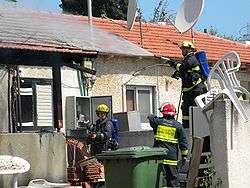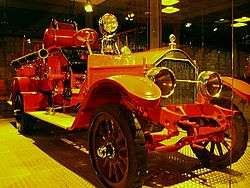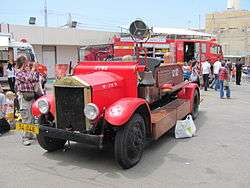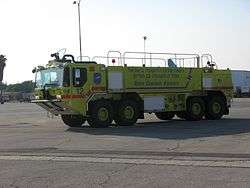Israel Fire and Rescue Services

The Israel Fire and Rescue Services (Hebrew: שֵׁירוּתֵי כַּבָּאוּת וְהַצָּלָה Sherutei Kaba'ut VeHatzala) also (Hebrew: הרָשׁוּת האַרְצִית לכַּבָּאוּת וְהַצָּלָה , haRashut haArtza'it leKaba'ut veHatzala ) is the Israeli state organization for fire fighting and rescuing. The organisation also provides rescue services from terror attacks, car accident and dangerous substance spillages, along with Magen David Adom, the National EMS. They are also involved in public education and awareness campaigns. The service is accessed by calling 102 from any phone. As of 2010, the director of the services is Shimon Romach.
Organization

There was 24 metro regions that have central major fire stations with supplemental smaller stations in neighboring villages and cities. After the "Carmel Disaster" in 2010 where many prison guards, civilians, police officer and two firefighters were burned to death, the government decided to create the Israel's Fire and Rescue Authority and organized like the police. The Israel Fire and Rescue Services consists of about 2,500 USD paid, professional fire fighters along with an additional 200-400 "fire-scout" volunteers. There are 11 Hazardous Materials Units in Israel. All stations provide auto-extrication and are equipped with the latest gear for rescue and fire suppression. Major stations have a heavy rescue unit and ladder truck company. The fire-rescue apparatus are custom built in Israel at Kibbutz Beit Alfa Industries on chassis of Mercedes-Benz, Man, Iveco, E-One, Chevrolet, and Ford modified to Israeli specifications in Israel. Most apparatus repairs and servicing is done by fire fighter/mechanics in-station, as most stations have a fully equipped mechanic garage with lifts, welding equipment, and tools.
Training

Almost all Israeli fire fighters are certified in Hazardous Materials response and handling, many of whom are trained in the world class Hazmat facilities in the Netherlands, and all have certifications in extrication, heavy rescue, heavy apparatus operation, wildland interface suppression, structure fire suppression and ventilation, as well as search and rescue.
A typical engine crew consists of two fire fighters for an automatic fire alarm and other non-structure fire calls, and most structure fire responses consists of two engine crews, a truck company, and a medium-duty rescue/suppression truck that also doubles as a commander's vehicle. Larger incidents may also require a communications vehicle, heavy rescue apparatus, and additional support/command units.
Their radio systems operate on a Motorola Conventional Wide Band System and most fire fighters also have beepers and/or motorola walkie-talkie phones.
History



After a fire in Zikhron Ya'akov in 1897, the first firefighting company was established by the Baron Rothschild. The company had 32 members, and equipment was brought from Paris, including pumps, hoses, ladders, axes and uniforms with shiny copper helmets and leather belts.[1]
Another company was formed in Tel Aviv in 1925 following a flood in the Brenner neighbourhood, and was based in the first dedicated fire station in the country, a shed near the police station. Throughout the following years, more firefighting companies and fire stations were established throughout the Yishuv. By Israeli independence in 1948 there were fire stations in most Jewish settlements; Petah Tikva, Jerusalem, Haifa, Hadera, Rehovot, Nahariya, Bnei Brak, Ramat Gan, Givatayim, Afula, Herzliya, Kfar Saba, Holon, Netanya and Rishon LeZion.

After Israeli independence, fire stations were built in several other cities, including Acre and Beersheba, at Lod Airport, the oil refineries in Haifa and at the ports of Port of Haifa and Port of Ashdod.
The Firefighting Services Law was passed in 1959 and took effect in 1960. It established a fully professional fire fighting force, as until then, firefighters had previously been volunteers.
Israel Fire and Rescue Services operates 5 fire stations in Jerusalem. The main station is in Givat Mordechai, with branches in Romema, Wadi al-Joz, Givat Ram and Neve Ya'akov.[2]
This page is now out of date. Since the Carmel Fire of December 2010, Israel's firefighting and rescue services have been transformed and upgraded from a municipal based structure into a national force. All firefighters and rescue personnel are now government employees under the Miinistry Of Public Security.
The reform is described on the National Firefighting Authority's homepage as follows:
The Fire Reform – Creating a National Fire Authority On July 25, 2012, the Knesset approved a law establishing a National Fire Authority. The law entails dismantling the local fire authorities and creating 7 districts under the control of the Fire Commission, within the Ministry of Public Security. Fire and Rescue Services National Fire Authority The law followed a government decision from January 2011, which, in light of the Mt. Carmel forest fire, called for the establishment of a National Fire Authority under the jurisdiction of the Ministry of Public Security.
Main Points of the Law The law changes the structure of the fire service from a municipality-based, divided force, into a single, unified, national force. The law also broadens the authority of the Fire Commissioner, who will now command over the force, determine the number and location of fire stations, and decide on the size of the force. As a result of the move to the Ministry of Public Security, all firefighters will now become government employees. In addition, the jurisdiction over hazardous materials will be transferred from the Environmental Protection Ministry to the Fire Commission. According to the government decision, the law must be implemented by February 1, 2013.
Making Changes In light of the new units being developed to meet the needs of the National Fire Authority, 300 new firefighters have been enlisted and an additional 30 positions in the fire commission were approved, including a deputy commissioner, head of operations and head of investigations. In addition, 22 units for special rescue missions involving heights and water have been established. Finally, an aerial firefighting unit was established under the command of the Air Force, and consists of eight aircraft, each with a capacity of 3,000 liters of water or foam.
Aside for adding personnel, the Fire Service has also made significant advancements in the field of technology. First, a national, state-of-the-art control center was constructed at the fire commission headquarters. In addition, the fire and rescue academy was renovated, including new dormitories, new lecture halls, a workout room, and new training equipment. Additionally, plans are in the works for designing a multi-purpose training facility which will include fire and smoke simulations. So far, eight new fire stations have been opened in locations across the country, and plans are in the way for an additional 14. Ninety new fire trucks have been supplied, and thousands of protective suits are being distributed to fire stations.
In addition, the “Shalhevet” command and control system, which manages the Fire and Rescue Service's operations, is being installed in all fire stations throughout the country, as well as in the aerial firefighting unit and in the Israel Prison Service. The system will later be installed in the Home-Front Command, JNF forest services, and the Israel Nature and Parks Authority. Furthermore, a communications network is being planned that will connect the Fire Service headquarters to the local stations through computers. Lastly, the development of the “Matash” fire prediction system has been completed, and has been operational since January 2012 in cities with large forest areas.
In order to bring the firefighters up to speed and advance their capabilities, many training exercises have been conducted, including large-scale exercises with multiple fire stations and additional emergency agencies; exercises simulating forest fires and earthquakes in cooperation with Israel Police helicopters; and other joint training sessions with the Home Front Command, JNF, the Nature and Parks Authority, Magen David Adom, and the National Emergency Authority.
In February 2013, the Israeli government nationalized the Fire and Rescue Services. Until then, the fire services had been operated by local authorities, who billed citizens for their services. Under the new program, the state finances the service as part of the government budget. It was announced that the reform would streamline efficiency and upgrade services. As a result of the reform, the fire service purchased dozens of new fire engines and new equipment, and an eight-aircraft strong firefighting squadron (expected to grow to 14) was established.[3]
References
| Wikimedia Commons has media related to Firefighting in Israel. |
External links
Updated References
- http://102.gov.il/About/Pages/About.aspx Official website - in Hebrew
- http://102.gov.il/English/Reform/Pages/default.aspx Official website - in English